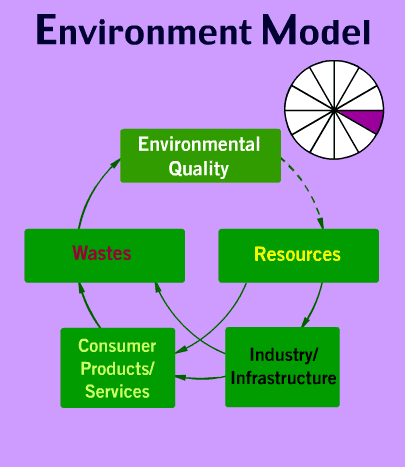
Date: 2025-12-13 Page is: DBtxt003.php txt00004440
Metrics
Calvert-Henderson Quality of Life Indicators
The Calvert-Henderson Environment Indicator
Burgess COMMENTARY
Peter Burgess
The Calvert-Henderson Environment Indicator reflects the complex interactions between the economic processes of human society and the natural world that provides the life support system for that society. The Calvert-Henderson Environment Model shows the interdependence of its five components:
- The environmental quality of the earth's natural systems
- The natural resources used by humans
- The human industry and infrastructure that supports our society
- The consumer products and services created by our society
- The waste generated by human industrial and societal activities

The model is an attempt to simplify a very complex subject, so there is some overlap between the components. A comprehensive evaluation of the environment would take many volumes, since each of the five components of the model is itself a complex system. Instead, the Calvert-Henderson Environment Indicator provides an overview, using a few key 'surrogate' indicators as proxies.
This systems approach to the environment demonstrates how many domains of quality of life-infrastructure design, energy use, shelter, health, employment, public safety, and national security-all impinge on the environment and life support systems, for better or worse.
Learn More about the Environment Indicator Click on the model (above left) or the options below to see the five sections of the Calvert-Henderson Environment Indicator:
- Environmental Quality
- Natural Resources and Ecosystems
- Industry and Infrastructure
- Consumers and Products
- Wastes
Click here to see more about the growing field of environmental indicators and sustainability criteria, including data on planetary ecosystems, the crucial role of biodiversity, and effect of human activities on the ozone layer and climate. These efforts include the Millennium Ecosystem Assessment, the Living Planet Report, coauthored by our Advisory Board expert, Mathis Wackernagel, and the Heinz Center's report on the State of the Nation's Ecosystems.